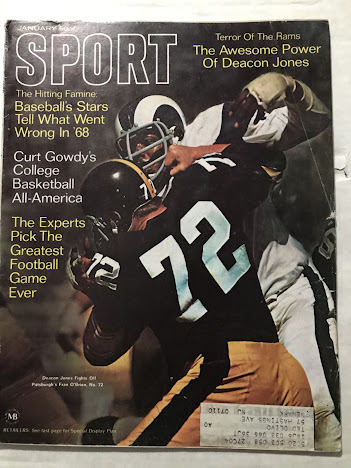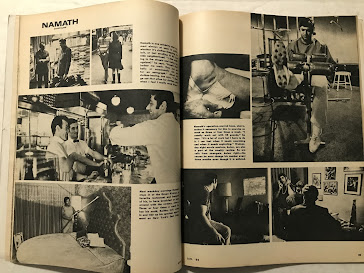This was a really fun read, very much a product of it's time.
Thanks to his World Series heroics Mickey Lolich won this 1969 Dodge Charger. He blocked Bob Gibson from winning his second straight car and third overall.Lots of humorous bits here, mostly football but there's a Cleon Jones appearance. The main section is about how Bears quarterback Virgil Carter would write plays on his pants.
Most of the advertising in the magazine was of the mail-order variety (weight loss, correspondence schools, etc). This Pontiac ad stands out though.
An article about the "flaky" Cardinals star Mike Shannon. Doesn't really come off as that flaky, just a little smarter and more opinionated than the average '60s ballplayer.
There was a really interesting photo spread on the week in the life of Joe Namath, the Jets quarterback who could be really good one week and really bad the next week. I love the caption on the lower right about Suzy Storm, "a Florida coed who sometimes comes up for the weekend".
A variety of photos from Joe's private life, including one of his maid vacuuming his headboard. Bundini's World, in one of the photos, was an Upper East Side singles bar owned by Muhammad Ali's trainer Drew "Bundini" Brown. The Green Kitchen still operates on 1st & 77th on the Upper East Side. It was known for a celebrity clientele in the 1970s.
Joe at work. Of course, he ended up having a pretty good January 1969.
A feature on rookie star Johnny Bench. Could he really be as good as Dickey, Berra, etc? Of course we know the answer now. He comes off as a gruff, all-business guy in this article by Al Stump, famous for the Ty Cobb book/movie. Best line was when an old man at a banquet started complaining about the Reds recent moves, saying he "was a big fan in the days when the Reds were winning!" Bench shoots him down with "Thank you, Mr. Frontrunner. Next question?"
An article about violence in baseball, centered around the Tigers Dick McAuliffe tackling the White Sox' Tommy John. John's shoulder was badly separated and it was unclear from this article if he would ever pitch again. Of course, John would come back, pitch again, have what should have been another career-ending injury, come back from that and pitch until he was 46. The article is very sympathetic to John and paints McAuliffe as the villain. Modern articles on the incident are much more pro-McAuliffe. I think that is because there are more fans nostalgic for the '68 Tigers than the '68 White Sox.
A profile of Satchel Paige, who was signed by the Braves as a player/coach at the age of 62 so he could be eligible for a pension, giving advice to young stars like Hank Aaron and Joe Torre.
In the days before the internet simple questions like these seemed to require a letter to Sport Magazine, though a trip to the local library would probably be easier and certainly quicker. Still, check out a younger Ernie Harwell and a very young Marv Albert.
Some weird stuff in the Market Place, particularly the International Girl Watchers Club.
Could any advertisement be more 1969?
A fascinating wish list for 1969. Among the notable wishes:
- "Auspicious pro debuts for two of the decade's most gifted collegians, Lew Alcindor in basketball and O.J. Simpson in football." Alcindor (Kareem Abdul-Jabbar) and Simpson would go on to stellar careers in their sports. Abdul-Jabbar was also a great man outside of his sport. Simpson, not so much.
- "One more great year for Mickey Mantle". Turns out Mantle had already played his last game; he would announce his retirement before the '69 season.
- "An agreement by baseball's brains (baseball's what?) to cut back the schedule for 1970, and play inter-league games." How many fans in the 1960s wanted interleague games?
Also very interesting was this bit:
"'I've given this a lot of thought,' said [Pete] Rose, 'and I think that somehow they should make a rule restricting the number of pitchers on a staff to eight or nine. Now, they've got a 50-grand reliever who comes in and throws one pitch and another 30-grand reliever who comes in and throws one pitch. I think without ruining baseball they could restrict the number on a staff.'
Joe Torre disagreed with the Rose plan. 'Maybe it might be a good idea, but I don't think it's fair,' Torre said. 'I don't want to take the bread out of anyone's mouth. And managers always would find some soft of way to get around this.'"
Torre ended up being a pioneer in specialized bullpen use as a Yankees manager. But it is interesting to see the same arguments that go on today being hashed out in an article from over 50 years ago.
Also in this issue, articles on: high school basketball player Tom McMillen (teenage athlete of the month); the experts pick football's greatest game (you can probably guess which they picked); Curt Gowdy's College Basketball All-Americans (notable names are Alcindor and Maravich); NY Rangers coach Bernie "Boom Boom" Geoffrion; Raiders running back Hewritt Dixon; NBA journeyman Walt Hazzard; college basketball star Jo Jo White; Cowboys cornerback Cornell Green (brother of former MLBer Pumpsie Green); "Pull!" which seems to be about hunting, but most of that page was ripped off, probably for the photo of Deacon Jones on the other side; the Deacon Jones cover story; Joe Garagiola on mound conversations (not as funny a piece as you'd think) and Howard Cosell on Roy "Wrong Way" Riegels. Other notable advertisers include the Army; Johnny Unitas for Head & Shoulders (the photo of Unitas was also cut out of the magazine); Chrysler, and the back cover ad for Remington shotguns.
















That Satchel Paige article would be interesting.
ReplyDeleteI love getting a look at these vintage / old school sports magazines.
ReplyDeleteLove seeing those classic cars. I wonder if Lolich still has that Charger.
ReplyDeleteOoh, I wanna hear more about this Suzy Storm :)
ReplyDelete